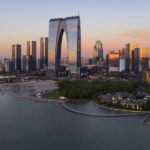 Countries around the world have developed various science and industrial parks to try and aid economic development. Nowhere has this been more so than in China, where over 1,400 such parks have been developed in recent decades. New research from MIT highlights the varying degrees of success of these parks and suggests that some of the most under-performing parks were developed largely due to political connections rather than economic necessity.
Countries around the world have developed various science and industrial parks to try and aid economic development. Nowhere has this been more so than in China, where over 1,400 such parks have been developed in recent decades. New research from MIT highlights the varying degrees of success of these parks and suggests that some of the most under-performing parks were developed largely due to political connections rather than economic necessity.
The study suggests that when city leaders and provincial political leaders have close ties, those cities are more likely to gain new industrial parks. Those parks tend to produce around 5% less GDP per capita than their counterparts in cities where such political connections don’t exist and decisions are made on economic grounds.
“We call it the price of the friendship,” the researchers explain. “That price is about 5 percent less GDP per capita than if you made the decision based on economic fundamentals.”
Political decisions
This kind of connectivity is sadly not small, with around a quarter of the provincial-level party secretaries having significant connections with city-level party secretaries, which undermines the economic rationale behind the 1,417 large industrial parks built in 276 cities across China in recent decades.
The paper reveals that the goods and services produced from these parks account for around 10% of China’s GDP. This is generally a great return as they require just 0.1% of its land. Indeed, the paper cites previous research showing that employment is 47% higher after an industrial park is created, with local economic output rising by 55%.
These benefits are not shared equally, however, with around 30% of the parks not generating much, if any, additional economic value. With local and regional decision-makers given a lot of autonomy in China, the researchers wanted to explore how politics can interfere in the effectiveness of each park.
“Mayors all want parks because they know it will potentially boost their cities’ local economies,” the researchers explain. “If the park can stimulate the economy, this is also good for the local provincial leader. But the other consideration is friendship—a provincial leader might reward his friend in return for loyalty and political support.”
The researchers attempted to account for a wide range of factors that may affect both the placement and the subsequent performance of each industrial park to allow for a fair comparison between each park.
The most successful parks seem to be those that build upon synergies with existing firms. This could be a relationship between suppliers and manufacturers, for instance. These were found to be key to the overall success of the park.
By contrast, the least successful were parks where no such logical synergies exist, with political ties often resulting in parks created in places with no logical basis.